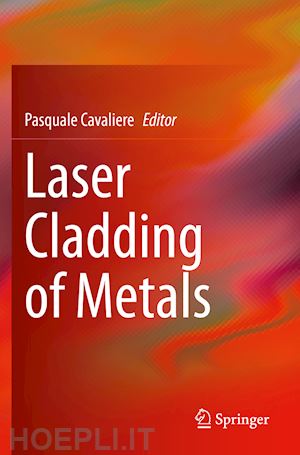

Questo prodotto usufruisce delle SPEDIZIONI GRATIS
selezionando l'opzione Corriere Veloce in fase di ordine.
Pagabile anche con Carta della cultura giovani e del merito, 18App Bonus Cultura e Carta del Docente
Laser cladding is an additive manufacturing technology capable of producing coatings due to the surface fusion of metals. The selected powder is fed into a focused laser beam to be melted and deposited as coating. This allows to apply material in a selected way onto those required sections of complex components. The process main properties are the production of a perfect metallurgically bonded and fully dense coatings; the minimal heat affected zone and low dilution between the substrate and filler material resulting in functional coatings that perform at reduced thickness, so fewer layers are applied; fine, homogeneous microstructure resulting from the rapid solidification rate that promotes wear resistance of carbide coatings; near net-shape weld build-up requires little finishing effort; extended weldability of sensitive materials like carbon-rich steels or nickel-based superalloys that are difficult or even impossible to weld using conventional welding processes; post-weld heat treatment is often eliminated as the small heat affected zone minimizes component stress; excellent process stability and reproducibility because it is numerical controlled welding process. The typical applications are the dimensional restoration; the wear and corrosion protection; additive manufacturing.
The wide range of materials that can be deposited and its suitability for treating small areas make laser cladding particularly appropriate to tailor surface properties to local service requirements and it opens up a new perspective for surface engineered materials. The main key aspect to be scientifically and technologically explored are the type of laser; the powders properties; the processing parameters; the consequent microstructural and mechanical properties of the processed material; the capability of fabrication of prototypes to rapid tooling and rapid manufacturing.
Introduction.- Laser cladding processing fundamentals.- Laser cladding process modelling.- Laser cladding additive manufacturing.- Laser cladding aerospace applications.- Laser cladding of Ni-based superalloys.- Laser cladding of Al alloys.- Laser cladding of Ti alloys.- Laser cladding of Iron based alloys.- Laser cladding of metal matrix composites.- Laser cladding of Co alloys.- Laser cladding of metallic glasses.- Laser cladding of High entropy alloys.
Pasaquale Cavaliere is an Associate Professor at the University of Salento in Italy. He received his PhD from the University of Rome. He has served as the Marie Curie Fellow at the Massachusetts Institute of Technology’s Materials Science and Engineering Department. He is the author of over 200 papers, which have garnered over 2000 citations.











Il sito utilizza cookie ed altri strumenti di tracciamento che raccolgono informazioni dal dispositivo dell’utente. Oltre ai cookie tecnici ed analitici aggregati, strettamente necessari per il funzionamento di questo sito web, previo consenso dell’utente possono essere installati cookie di profilazione e marketing e cookie dei social media. Cliccando su “Accetto tutti i cookie” saranno attivate tutte le categorie di cookie. Per accettare solo deterninate categorie di cookie, cliccare invece su “Impostazioni cookie”. Chiudendo il banner o continuando a navigare saranno installati solo cookie tecnici. Per maggiori dettagli, consultare la Cookie Policy.